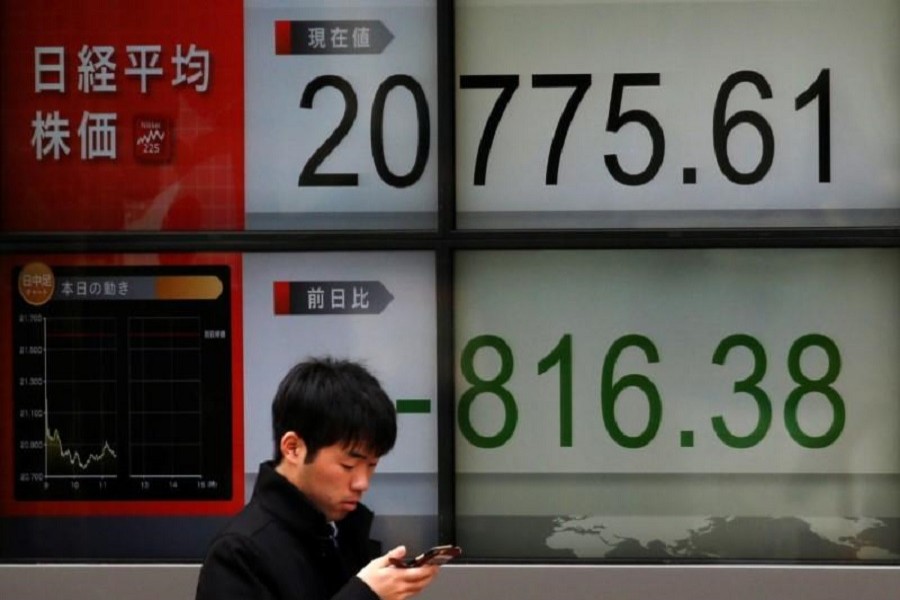Asian share markets rallied from nine-month lows on Friday, after China eased foreign investment limits, but underlying sentiment was dampened by worries over trade frictions a week before initial US and Chinese tariffs were set to take effect.
MSCI’s broadest index of Asia-Pacific shares outside Japan was 1.0 per cent higher, while Australian shares were flat.
Japan’s Nikkei stock index was down 0.3 per cent, and South Korea’s KOSPI was down slightly.
After falling to fresh two-year lows on Thursday, shares in China rebounded on Friday. While analysts said the jump reflected technical factors, it was helped by news that Beijing would ease foreign investment curbs on sectors including banking, automobiles, heavy industry and agriculture.
The country’s central bank also said on Thursday that it would ensure that market liquidity remained “reasonably ample.”
The blue-chip CSI300 index gained 1.5 per cent, and the Shanghai Composite index was 1.1 per cent higher. Nevertheless, the CSI300 and Shanghai Composite are the world’s two worst-performing major indexes this year, and are set for their worst monthly performances since January 2016.
Hong Kong’s Hang Seng index rose 1.2 per cent.
Despite the bump on Friday, analysts downplayed the impact of China’s relaxing of investment curbs on broader trade issues.
“This may not be enough to ease current tensions, with the U.S. calling for much greater market access and fairer competition for foreign enterprises. The list affirms China’s stance that opening up will occur in its own timeframe,” Everbright Sun Hung Kai analysts said in a note.
Elsewhere in the region, investors remained focused on concerns over global trade, as the US ambassador to China said Washington was not convinced that China is willing to make fast progress on trade.
The US administration is due to activate US tariffs on Chinese goods worth $34 billion on July 6, which is expected to prompt a tit-for-tat response from Beijing.
“The trade war issue is coming up to a critical junction because of that impending implementation of those tariffs,” said Shane Oliver, chief economist and head of investment strategy at AMP Capital in Sydney.
While the scope of the initial tariffs is limited, “investors just worry that (tariffs are) going to lead to more retaliation and then escalation,” he said.
The US dollar index, which measures the greenback against a basket of six currencies, fell 0.5 per cent to 94.914. The currency has risen in recent weeks, helped by the US Federal Reserve’s move to raise interest rates in June, and expectations of further hikes this year.
“The ongoing drip feed of high US interest rates is creating consternation,” said Oliver. “Obviously it’s pushing up the US dollar and putting downward pressure on Asian currencies generally, including the renminbi, and that could well have further to go.”
The Chinese yuan traded as low as 6.6441 to the dollar on Friday, its lowest level since November.
The dollar was up 0.2 per cent against the yen at 110.73. The euro jumped after EU leaders reached an agreement on migration. The single currency was up 0.6 per cent to $1.1635 at 0305 GMT.
The yield on benchmark 10-year Treasury notes rose to 2.8547 per cent compared with its US close of 2.847 per cent on Thursday.
The two-year yield, which rises with traders’ expectations of higher Fed fund rates, was at 2.5242 per cent compared with a US close of 2.52 per cent.
Oil prices also came under pressure from trade frictions, falling despite tight crude market conditions that had pushed prices to three-and-a-half-year highs on Thursday, Reuters reported.
US crude dipped 0.4 per cent to $73.16 a barrel. Brent crude was 0.3 per cent lower at $77.65 per barrel. Gold remained near six-month lows, weighed down by trade worries, interest rate expectations and the strong dollar.
On Friday, spot gold was trading slightly higher at $1248.71 per ounce, but was still headed for its worst monthly performance since November 2016.


